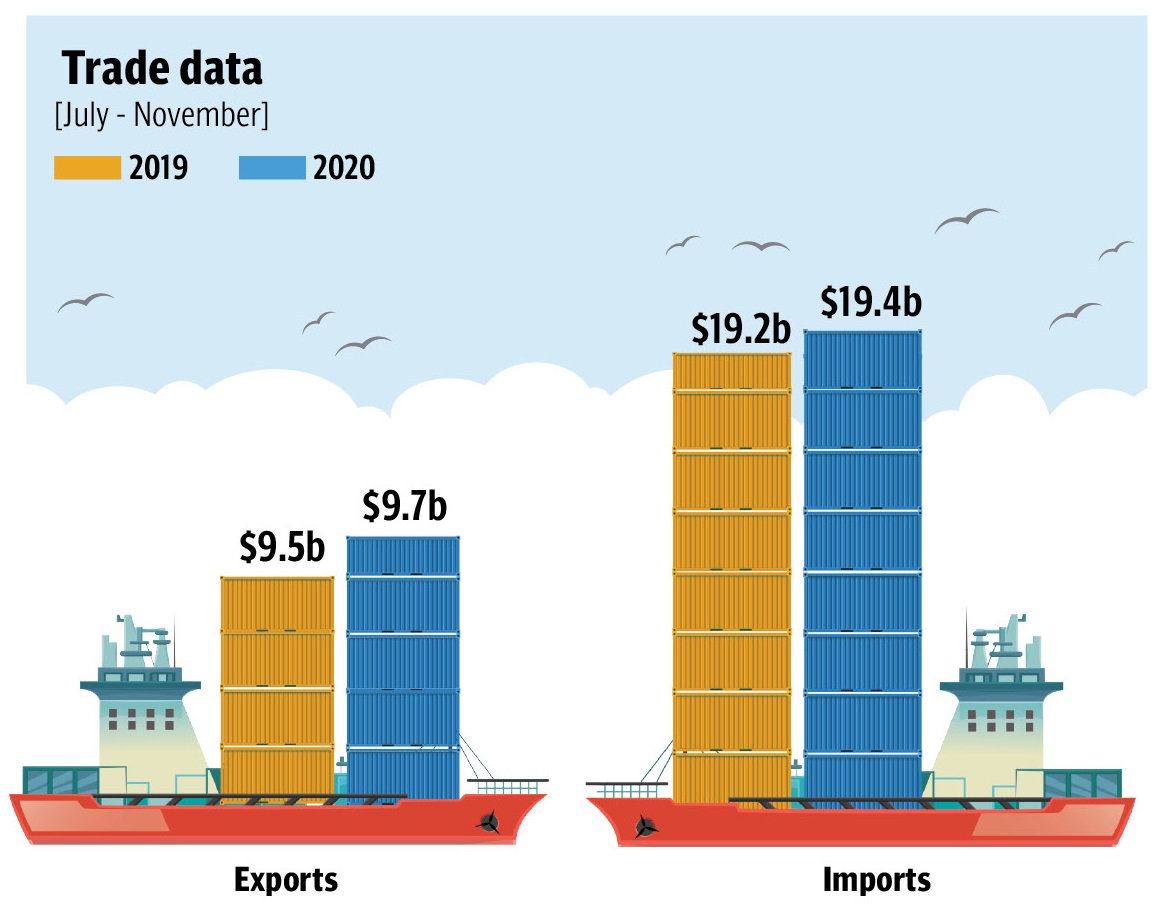Trade deficit widens to $9.6b
Exports and imports record nominal increase in five-month period

Pakistan’s trade deficit marginally widened to $9.6 billion in first five months of current fiscal year on the back of a nominal increase in both exports and imports, the Pakistan Bureau of Statistics (PBS) reported on Friday.
During July-November 2020, exports slightly increased by 2.1% and stood at $9.7 billion as compared to $9.5 billion in the same period of last year, according to the national data collecting agency.
In absolute terms, there was an increase of $201 million in exports in five months. Imports that were on a declining path have started picking up - a trend indicating restoration of economic activities but also signalled widening of the trade deficit.
Imports during the JulyNovember period increased 1.3% or $247 million to $19.4 billion.

DESIGN: MOHSIN ALAM
As a result, the balance of trade recorded a marginal increase of 0.5% to $9.7 billion, stated the PBS. The Pakistan Tehreek-eInsaf (PTI) government has been struggling to bring improvement in exports, despite its claim that there was a significant surge in export orders.
Exporters say there has been an increase in export orders due to the US-China trade war that shifted clients to India, Pakistan and Bangladesh.
“International buyers that had run out of stocks due to suspension of global trade in the aftermath of Covid19 have also started building their inventories,” said Pakistan Textile Exporters Association (PTEA) Secretary General Azizullah Goher.
However, Goher said it had to be seen whether the increase in export orders was a temporary phenomenon or the country could sustain it in the long run.
Pakistan’s exports have long remained around $2 billion a month and the trend did not significantly change despite 39% currency depreciation during the PTI government’s tenure in the past two years.
The rupee has also started recovering some of the lost value and is now trading around 160 to a dollar. The government has already missed the annual export target in its first two years. For the current fiscal year, it has set the export target at $27.7 billion, which will require only 6.2% growth.
However, exports in the first five months were equal to only 35% of the annual target. Imports in the current fiscal year are projected to contract 4.8% to $42.4 billion.
But imports in the first five months were equal to about 46% of the annual target. On an annual basis, the trade deficit in November 2020 compared to the same month a year ago widened 7.9% from $1.9 billion to $2.1 billion due to an equal increase in exports and imports in terms of percentage.
In absolute terms, there was an increase of $151 million in the trade deficit on an annual basis.
In November 2020, imports surged to $4.2 billion compared to $3.9 billion in the same month of last year, which reflected an increase of 7.8% or $305 million.
Exports increased 7.7% to $2.16 billion in November, a net rise of $154 million. On a month-on-month basis, exports grew 2.7% in November over October this year.
There was an increase of $57 million in export receipts as compared to the preceding month. But total monthly exports were only $2.16 billion. Imports registered an increase of 8.2% and stood at $4.2 billion last month.
There was an increase of $322 million in imports within a month. As a result, the trade deficit widened 14.7% or $265 million in November over October.
There is a different set of data reported by the PBS and the State Bank of Pakistan (SBP). During the first four months, the PBS had reported a nominal increase of 0.6% in exports but the central bank showed a negative growth of 10.3% in exports.
Earlier, the difference between the PBS and SBP data was nominal, which has now significantly increased and efforts by different government agencies to reconcile the statistics have not proved fruitful.



















COMMENTS
Comments are moderated and generally will be posted if they are on-topic and not abusive.
For more information, please see our Comments FAQ